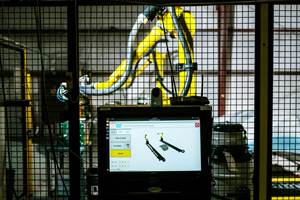Data Rich, Information Poor
Examine and measure large data sets to uncover hidden patterns and compare it with other finishing companies.
My father worked for General Electric in the jet engine plant in Ohio, and he always had an expression that I’m sure he picked up in the workplace: “What gets measured gets improved.”
I found out later that the quote came from Peter Drucker, a management consultant whose words became a beacon of the foundations of modern business.
In essence, how can you improve anything if you don’t know how efficient it is running? Is it humming along? Is it sporadic? Are you above or below average? By the way, my father also used to say, “Half the people in this world are below average.” This rings true sometimes when I am out and about in our world.
It seems a lot of businesses have always believed they were operating at or near their most proficient capabilities, but how do you fully know unless you measure and analyze data, and compare it with others around you?
Many in the manufacturing industry—including those in the surface finishing industry—are asking the same question.
A recent study by the Manufacturers Alliance for Productivity and Innovation (MAPI) showed that 87 percent of those in the manufacturing sector say that “big data analytics” is among their top three priorities in running the company. In fact, 42 percent say it is their No. 1 priority when it comes to running overall operations.
However, only 5 percent say they have implemented a big data strategy.
According to Techtarget.com, the definition of big data analytics is “the process of examining large data sets containing a variety of data types to uncover hidden patterns, unknown correlations, market trends, customer preferences and other useful business information.” Analytical findings can lead to more effective marketing, new revenue opportunities, better customer service, improved operational efficiency, competitive advantages over rival organizations and other business benefits.
“There’s a lot of resistance coming from manufacturing,” says Dan Meier, operations manager at Photoronics Inc. “We resist change because we don’t know what we don’t know. So transforming the mess of data that we routinely collect into a useful asset really has to be a process. It has to be a very focused and considered process.”
MAPI says it’s a common affliction amongst some in the manufacturing sector: They are data rich, information poor. The challenge is taking a lot of data that they are probably already accumulating in their operations and sifting through it to properly drive operational efficiencies and achieve an even higher level of service and support to customers.
Software maker Tableau is helping companies harness all that data into something that can become useful. They have come out with a pretty simplistic way of helping manufacturers use data to transform their companies, saying there are four basic ways a company can revolutionize its industry with data:
- Improve production, plant performance and product with self-service analytics.
- Enhance sales and operations planning with data blending and forecasting.
- Mobilize supply chain with real-time analytics.
- Listen, interpret and react to customer feedback faster.
Tableau suggests looking at the way electric vehicle maker Tesla Motors Designs used self-service analytics—meaning they gave its employees the ability to explore their own data—to discover some things about its own production improvement process.
“Once you start giving access to data to people, they start asking more questions,” says Will Bishop, senior test engineer at Tesla. “And there’s the ability to kind of dig deeper. If you’re trying to root cause some nagging issue that’s been kind of hurting production for weeks or months, looking into that
data and seeing things we’ve never seen before has been a
big win.”
Another example of taking a hard look at big-data analytics is Trane, maker of air conditioning systems and equipment. Tableau showed how Trane went from just using spreadsheets to using data visualizations with customer service data to get a better feel for how they were satisfying their customers.
“We need to listen, and we need to interpret that data,” says Michael Nealy, senior customer analyst from Trane. “And we want to quickly react in two ways. We want to react directly by responding to our customers. We also want to react as a business and strategically determine what is important to our customers.”
For those in the finishing industry, there is no reason not to collect data and manage every facet of your operations. As Trane learned, the data could be telling you something very important. And now is the time to listen.
Originally published in the May 2016 issue.
Related Content
Understanding Shot Peening
A look inside shot peening — a process of “hammering” of work pieces with precisely defined blast media.
Read MoreAI-Powered Robotic Solutions Support High-Mix Finishing
AI startup offers automation innovations for high-mix, high-variability, manual surface finishing applications.
Read MoreVulkan Blast Shot Technology
Vulkan Blast Shot Technology is a pioneer in the stainless steel abrasives market.
Read MoreBlasting Beads Made of Lead-Free Natron Glass
SwarcoBlast blasting media are made for use in a multitude of surface refinement applications.
Read MoreRead Next
Education Bringing Cleaning to Machining
Debuting new speakers and cleaning technology content during this half-day workshop co-located with IMTS 2024.
Read MoreEpisode 45: An Interview with Chandler Mancuso, MacDermid Envio Solutions
Chandler Mancuso, technical director with MacDermid Envio discusses updating your wastewater treatment system and implementing materials recycling solutions to increase efficiencies, control costs and reduce environmental impact.
Read MoreDelivering Increased Benefits to Greenhouse Films
Baystar's Borstar technology is helping customers deliver better, more reliable production methods to greenhouse agriculture.
Read More




.jpg;maxWidth=300;quality=90)
















